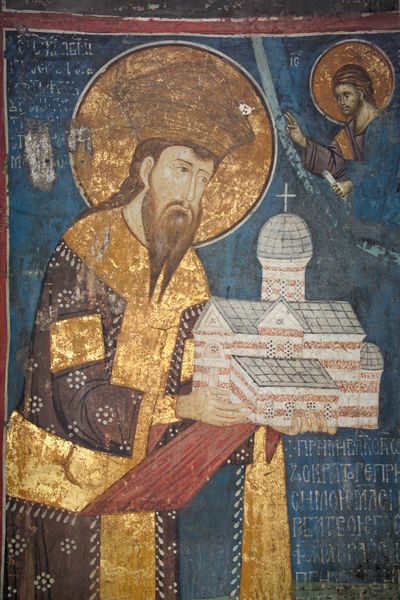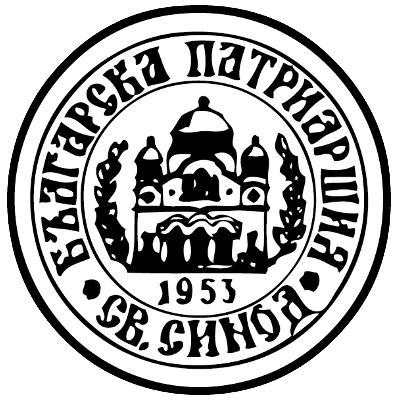|
Joachim II Of Bulgaria
Joachim II ( bg, Йоаким) was a Patriarch of the Bulgarian Orthodox Church in the mid 13th century. He is listed in the medieval ''Book of Boril'' as the third Patriarch presiding over the Bulgarian Church from Tarnovo, the capital of the Bulgarian Empire. Joachim II is also mentioned in a ''ktitor'' inscription in a rock monastery near the village of Troitsa on the territory of modern Shumen Plateau Nature Park. The church was consecrated in 1265 and was named after the Saints Nicholas and Andrew. Joachim II lead the Bulgarian Church during the reign of Emperor Konstantin Tih Konstantin Tih ( bg, Константин Тих Асен) or Constantine I Tikh (Константин I), was the tsar of Bulgaria from 1257 to 1277, he was offered the throne from Mitso Asen. He led the Bulgarian Empire at a time when the nearb ... (r. 1257–1277). References Sources * {{DEFAULTSORT:Joachim II 13th-century births 13th-century deaths 13th-century Bulgarian peopl ... [...More Info...] [...Related Items...] OR: [Wikipedia] [Google] [Baidu] |
Patriarch Of All Bulgaria
The Patriarch of All Bulgaria is the patriarch of the Bulgarian Orthodox Church. The patriarch is officially styled as ''Patriarch of All Bulgaria and Metropolitan of Sofia''. Patriarch Neophyte acceded to this position on 24 February 2013. History Medieval era Following two decisive victories over the Byzantines at Achelous (near the present-day city of Burgas) and Katasyrtai (near Constantinople), the autonomous Bulgarian Archbishopric was proclaimed autocephalous and elevated to the rank of patriarchate at an ecclesiastical and national council held in 918 or 919. As a result of the Treaty of 927, which affirmed the Bulgarian victory in the Byzantine–Bulgarian war of 913–927, the Patriarchate of Constantinople recognized the autocephalous status of the Bulgarian Orthodox Church and acknowledged its patriarchal dignity. Demetrius of Bulgaria was the second Patriarch of the Bulgarian Orthodox Church and the first one to have been recognized by the Ecumenical Patria ... [...More Info...] [...Related Items...] OR: [Wikipedia] [Google] [Baidu] |
13th-century Bulgarian People
The 13th century was the century which lasted from January 1, 1201 ( MCCI) through December 31, 1300 ( MCCC) in accordance with the Julian calendar. The Mongol Empire was founded by Genghis Khan, which stretched from Eastern Asia to Eastern Europe. The conquests of Hulagu Khan and other Mongol invasions changed the course of the Muslim world, most notably the Siege of Baghdad (1258), the destruction of the House of Wisdom and the weakening of the Mamluks and Rums which, according to historians, caused the decline of the Islamic Golden Age. Other Muslim powers such as the Mali Empire and Delhi Sultanate conquered large parts of West Africa and the Indian subcontinent, while Buddhism witnessed a decline through the conquest led by Bakhtiyar Khilji. The Southern Song dynasty would begin the century as a prosperous kingdom but would eventually be invaded and annexed into the Yuan dynasty of the Mongols. The Kamakura Shogunate of Japan would be invaded by the Mongols. Go ... [...More Info...] [...Related Items...] OR: [Wikipedia] [Google] [Baidu] |
13th-century Deaths
The 13th century was the century which lasted from January 1, 1201 ( MCCI) through December 31, 1300 ( MCCC) in accordance with the Julian calendar. The Mongol Empire was founded by Genghis Khan, which stretched from Eastern Asia to Eastern Europe. The conquests of Hulagu Khan and other Mongol invasions changed the course of the Muslim world, most notably the Siege of Baghdad (1258), the destruction of the House of Wisdom and the weakening of the Mamluks and Rums which, according to historians, caused the decline of the Islamic Golden Age. Other Muslim powers such as the Mali Empire and Delhi Sultanate conquered large parts of West Africa and the Indian subcontinent, while Buddhism witnessed a decline through the conquest led by Bakhtiyar Khilji. The Southern Song dynasty would begin the century as a prosperous kingdom but would eventually be invaded and annexed into the Yuan dynasty of the Mongols. The Kamakura Shogunate of Japan would be invaded by the Mongols. Goryeo resist ... [...More Info...] [...Related Items...] OR: [Wikipedia] [Google] [Baidu] |
Konstantin Tih
Konstantin Tih ( bg, Константин Тих Асен) or Constantine I Tikh (Константин I), was the tsar of Bulgaria from 1257 to 1277, he was offered the throne from Mitso Asen. He led the Bulgarian Empire at a time when the nearby Byzantine Empire disintegrated into rump states. To strengthen his position, he forged an alliance with one of the rump state—Nicaea—by marrying Irene, a daughter of Theodore II of the prominent Laskaris family. Early in his reign, his army invaded Severin, Hungary which outraged Béla IV; this led Hungarian troops to capture Vidin, an important town of the Bulgarian Empire and also saw the Hungarians besieging the Lower Danube region, leaving northwestern Bulgaria to Rostislav Mikhailovich (Béla's son-in-law), who had claimed Bulgaria in the years prior. When Michael VIII took over the throne of the Byzantine Empire (which led Konstantin to go to war with them in the 1260s) this saw Bulgaria losing significant territories to it ... [...More Info...] [...Related Items...] OR: [Wikipedia] [Google] [Baidu] |
Bulgarian Academy Of Sciences
The Bulgarian Academy of Sciences (abbreviated BAS; bg, Българска академия на науките, ''Balgarska akademiya na naukite'', abbreviated ''БАН'') is the National Academy of Bulgaria, established in 1869. The Academy, with headquarters in Sofia, is autonomous and consists of a Society of Academicians, Correspondent Members and Foreign Members. It publishes and circulates different scientific works, encyclopaedias, dictionaries and journals, and runs its own publishing house. The activities are distributed in three main branches: ''Natural, mathematical and engineering sciences''; ''Biological, medical and agrarian sciences'' and ''Social sciences, humanities and art''. They are structured in 42 independent scientific institutes, and a dozen of laboratories and other sections. Julian Revalski has been the president of the BAS since 2016. As of 2021, its budget was 117,8 million leva (€60,2 million). History As Bulgaria was part of the Ottoman E ... [...More Info...] [...Related Items...] OR: [Wikipedia] [Google] [Baidu] |
Shumen Plateau Nature Park
, iucn_category = , photo = Shumen plateau forest.jpg , photo_caption = Shumen Plateau forest near Shumen , location = Shumen Heights, Shumen Province, Bulgaria , nearest_city = Shumen , map = Bulgaria , relief = 1 , coordinates = , area = , established = 1980 as national park, and as nature park in 2003 , visitation_num = , visitation_year = , governing_body = , url = } The Shumen Plateau Nature Park ( bg, Природен парк Шуменско плато) is located in the Shumen Plateau of the northern province of Shumen of Bulgaria, the highest plateau of the Danubian Plain. The Park encloses the Bukaka Reserve Forest, which is known for indigenous Fagus sylvatica ''Fagus sylvatica'' (common beech) ''moesiaca'' (the Balkan beech) forest. This Park was declared a National Park in 1980 and a Nature Park in 2003 to conserve its ecosystems and floral and faunal biodiversity, and to preserve its tableland landscape together with many tourist sites such as the ... [...More Info...] [...Related Items...] OR: [Wikipedia] [Google] [Baidu] |
Ktitor
''Ktetor'' ( el, κτήτωρ) or ''ktitor'' (; ka, ქტიტორი ''kt’it’ori''; ro, ctitor), meaning "founder", is a title given in the Middle Ages to the provider of funds for construction or reconstruction of an Eastern Orthodox church or monastery, for the addition of icons, frescos, and other works of art. It was used in the Byzantine sphere. A Catholic equivalent of the term is "donator". At the time of founding, the ktetor often issued typika A typikon (or ''typicon'', ''typica''; gr, , "that of the prescribed form"; Slavonic: Тvпико́нъ ''Typikonə'' or Оуставъ, ''ustavə'') is a liturgical book which contains instructions about the order of the Byzantine Rite off ..., and was illustrated on frescoes ("ktetor portrait"). The female form is ''ktetorissa'' ( el, κτητόρισσα) or ''ktitoritsa'' (). Sources * * History of Eastern Orthodoxy Philanthropy Byzantine culture Greek words and phrases {{Orthodoxy-stub ... [...More Info...] [...Related Items...] OR: [Wikipedia] [Google] [Baidu] |
Bulgarian Orthodox Church
The Bulgarian Orthodox Church ( bg, Българска православна църква, translit=Balgarska pravoslavna tsarkva), legally the Patriarchate of Bulgaria ( bg, Българска патриаршия, links=no, translit=Balgarska patriarshiya), is an autocephalous Orthodox jurisdiction. It is the oldest Slavic Orthodox church, with some 6 million members in Bulgaria and between 1.5 and 2 million members in a number of European countries, the Americas, Australia, New Zealand and Asia. It was recognized as autocephalous in 1945 by the Ecumenical Patriarchate of Constantinople. History Early Christianity The Bulgarian Orthodox Church has its origin in the flourishing Christian communities and churches set up in the Balkans as early as the first centuries of the Christian era. Christianity was brought to the Balkans by the apostles Paul and Andrew in the 1st century AD, when the first organised Christian communities were formed. By the beginning of the ... [...More Info...] [...Related Items...] OR: [Wikipedia] [Google] [Baidu] |
Second Bulgarian Empire
The Second Bulgarian Empire (; ) was a medieval Bulgarian state that existed between 1185 and 1396. A successor to the First Bulgarian Empire, it reached the peak of its power under Tsars Kaloyan and Ivan Asen II before gradually being conquered by the Ottomans in the late 14th century. Until 1256, the Second Bulgarian Empire was the dominant power in the Balkans, defeating the Byzantine Empire in several major battles. In 1205, Emperor Kaloyan defeated the newly established Latin Empire in the Battle of Adrianople. His nephew Ivan Asen II defeated the Despotate of Epiros and made Bulgaria a regional power again. During his reign, Bulgaria spread from the Adriatic to the Black Sea and the economy flourished. In the late 13th century, however, the Empire declined under constant invasions by Mongols, Byzantines, Hungarians, and Serbs, as well as internal unrest and revolts. The 14th century saw a temporary recovery and stability, but also the peak of Balkan feudalism as c ... [...More Info...] [...Related Items...] OR: [Wikipedia] [Google] [Baidu] |






